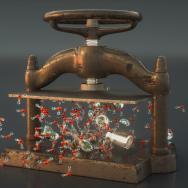Materials capable of performing complex functions in response to changes in the environment could form the basis for exciting new technologies. Think of a capsule implanted in your body that automatically releases antibodies in response to a virus, a surface that releases an antibacterial agent when exposed to dangerous bacteria, a material that adapts its shape when it needs to sustain a particular weight, or clothing that senses and captures toxic contaminants from the air.
Scientists and engineers have already taken the first step toward these types of autonomous materials by developing “active” materials that have the ability to move on their own. Now, researchers at the University of Chicago have taken the next step by showing that the movement in one such active material—liquid crystals—can be harnessed and directed.
This proof-of-concept research, published Feb. 18 in the journal Nature Materials, is the result of three years of collaborative work by the groups of Juan de Pablo, Liew Family Professor of Molecular Engineering, and Margaret Gardel, Horace B. Horton Professor of Physics and Molecular Engineering, along with Vincenzo Vitelli, professor of physics, and Aaron Dinner, professor of chemistry.
Harnessing the properties of liquid crystals
In contrast to traditional liquids, liquid crystals exhibit a uniform molecular order and orientation that offer potential as building blocks for autonomous materials. Defects within the crystals are essentially tiny capsules that could act as sites for chemical reactions or as transport vessels for cargo in a circuit-like device.
To create autonomous materials that can be used in technologies, scientists needed to find a way to have these materials self-propel their defects while controlling the direction of the movement.
To make “active” liquid crystals, the researchers used actin filaments, the same filaments that constitute a cell’s cytoskeleton. They also added in motor proteins, which are the proteins that biological systems use to exert force in actin filaments. These proteins essentially “walk” along the filaments, causing the crystals to move.
In this case, in collaboration with the group of Prof. Zev Bryant at Stanford University, the researchers developed active liquid crystals powered by light-sensitive proteins, whose activity increases when exposed to light.
Using advanced computer simulations of models developed by de Pablo with postdoctoral fellows Rui Zhang and Ali Mozaffari, the researchers predicted that they could create defects and manipulate them by creating local patterns of activity in a liquid crystal.
Experiments led by Gardel and postdoctoral fellows Steven Redford and Nitin Kumar confirmed these predictions. Specifically, by shining a laser on different regions, the researchers made those regions more or less active, thereby controlling the flow of the defect.
They then showed how this could be used to create a microfluidic device, a tool that researchers in engineering, chemistry, and biology use to analyze small amounts of liquids.
Usually such devices include tiny chambers, tunnels and valves; with a material like this, fluids could be transported autonomously without pumps or pressure, opening the door for programming complex behaviors into active systems.
The discoveries presented in the manuscript are significant because, until now, much of the research on active liquid crystals has been focused on characterizing their behavior.
“In this work we have showed how to control these materials, which could pave the way for applications,” de Pablo said. “We now have an example where molecular-level propulsion has been harnessed to control motion and transport over macroscopic scales.”
Creating new devices from the material
This proof-of-concept shows that a system of liquid crystals could ultimately be used as a sensor or an amplifier that reacts to the environment. Next, the researchers hope to demonstrate how to build the necessary elements needed to make this system into a circuit capable of performing logic operations in the same way as computers do.
“We knew these active materials were beautiful and interesting, but now we know how to manipulate them and use them for interesting applications,” de Pablo said. “That’s very exciting.”
Other authors on the paper include Sasha Zemsky and Paul V. Ruijgrok of Stanford. This collaborative effort was enabled by the UChicago Materials Research Science and Engineering Center. Gardel, Vitelli and Dinner are members of the James Franck Institute.
Citation: “Spatiotemporal control of liquid crystal structure and dynamics through activity patterning,” Zhang et al, Nature Materials, Feb. 18. 2021, DOI: 10.1038/s41563-020-00901-4
Funding: National Science Foundation
—Adapted from an article first published by the Pritzker School of Molecular Engineering.












 —Prof. Kunle Odunsi
—Prof. Kunle Odunsi
